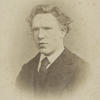More about A Weaver's Cottage
- All
- Info
- Shop

Contributor
Tragedy looms large in A Weaver’s Cottage, both figuratively and literally.
There’s no way around it. This is a sad painting. The colors, the sullen expression, and the devastating subject matter of a livelihood falling apart.
In 1884, Van Gogh committed himself to artworks depicting rural laborers. He had recently moved back to Nuenen in Brabant, a small Dutch village where his parents lived. Things weren’t great. In spite of the surrounding arable land, these were no salad days. To clear his mind, he would leave the house to explore Nuenen. He came across farmers, fieldhands, and peasants, painting them as he went. These figures captured his imagination. These were individuals who stood opposed to the life that was booming in the bigger cities. These were individuals who were doing jobs that were no longer desirable, like that of a weaver.
To weave by hand in 1884 was not very profitable. John Kay’s 'Flying Shuttle,' which sounds like an early whirligig but was actually an apparatus that reduced the amount of labor necessary for weaving by half, had already helped precipitate the Industrial Revolution. Joseph Jacquard, too, had invented his fancy-pants redux of the mechanized power loom about fifty years earlier that simplified the artistry of the craft to rather simple inputs on a graph.
There is no wonder, then, that the man who stands behind the handloom stands with a sullen face. The world didn’t have much room left for the slow, methodical, and expensive fabric produced by hand looming. The weaver’s face, which is rendered in dark browns and thick straight lines for eyes and mouth, suggest a pained resignation for a fallen fate. This is the painted equivalent of well, this sucks. It’s particularly depressing when you think about how handweaving might in fact be the oldest of the industrial arts.
Around the time of this painting, Van Gogh wrote in a letter to his brother Theo that the weaver had no time to philosophize his work, he had to act. As a struggling artist himself who lived off of the money he received from his brother in exchange for artworks, Van Gogh must have felt a strong affinity for those who wove. Van Gogh, like the weaver, was an artist who struggled with the decision of contemplating his work, or producing it as fast as he could. He needed food, rent, and art supplies, too. Honestly, Van Gogh could be the millennial hero, but over a hundred years too early.
As for the painting, you still can’t escape how dour it is. You want to jump in and attempt to patch things up, but, alas, you can’t. The only thing that cheers you up are poorly woven puns about looms and our social fabric. Keep your foot on the pedal; you’ll thread the needle, eventually.
Sources
- Van Gogh, Vincent. "Letter from Vincent Van Gogh to Theo Van Gogh, The Hague, 11 March 1883." Webexhibits. Accessed January 2019. http://www.webexhibits.org/vangogh/letter/12/274.htm.
- "A Weaver's Cottage." Museum Boijmans Van Beuningen. Accessed January 2019. https://www.boijmans.nl/en/collection/artworks/1216/a-weaver-s-cottage.
- Todd, Marie Phillips. "Hand-Loom Weaving,." Alice's Adventures in Wonderland, by Lewis Carroll. Accessed January 2019. https://www.gutenberg.org/files/31630/31630-h/31630-h.htm.













